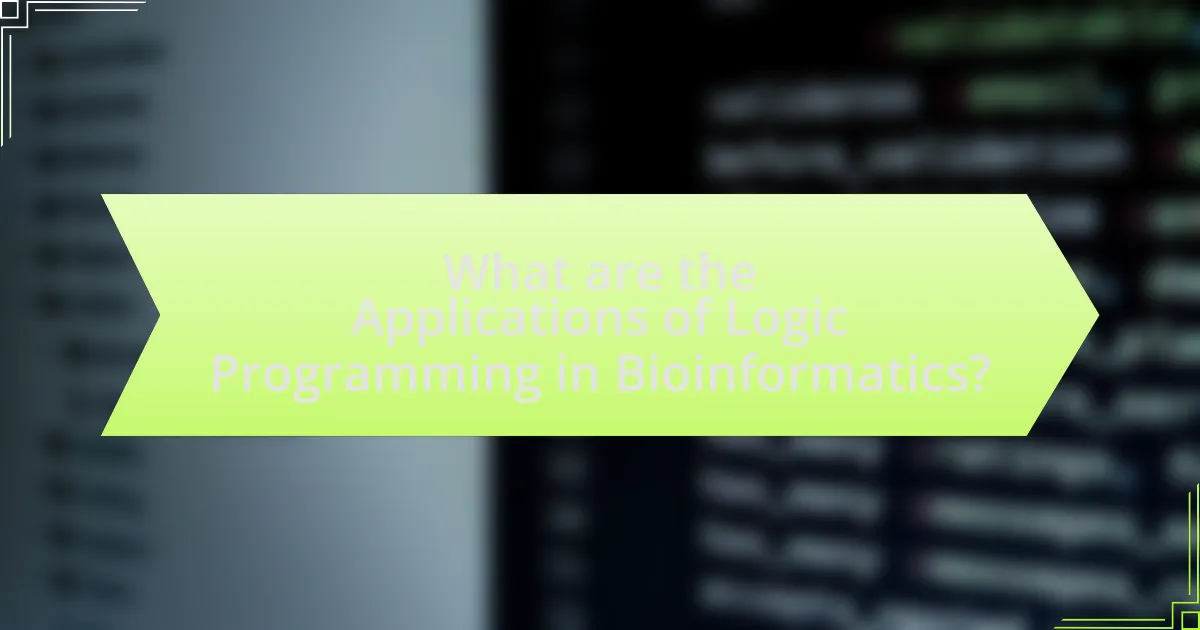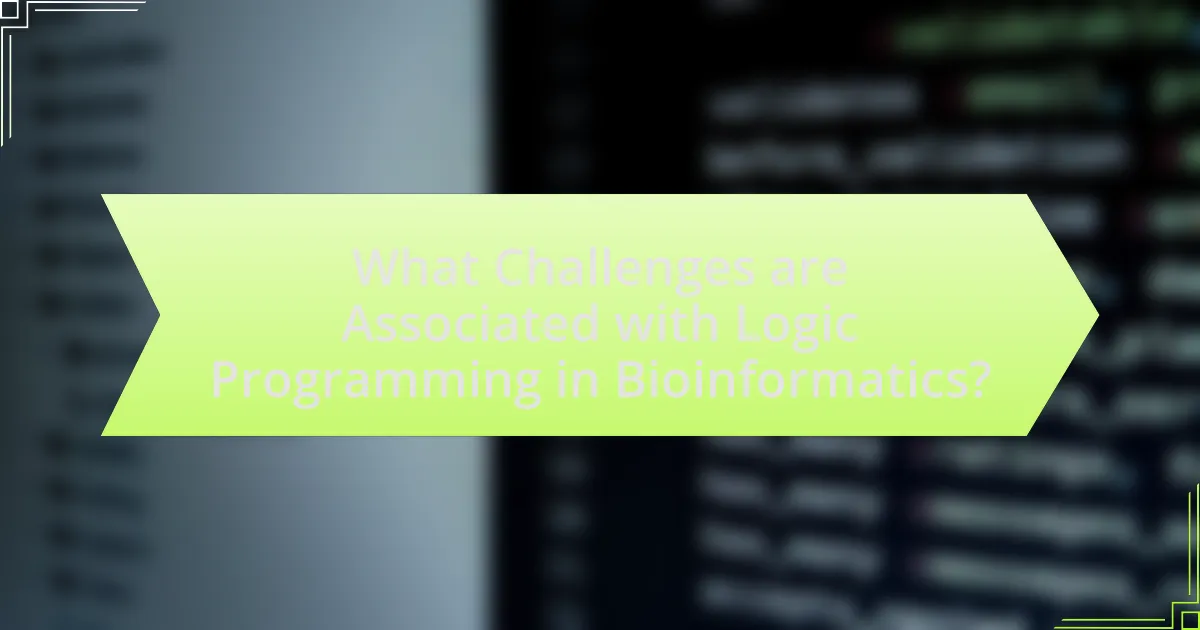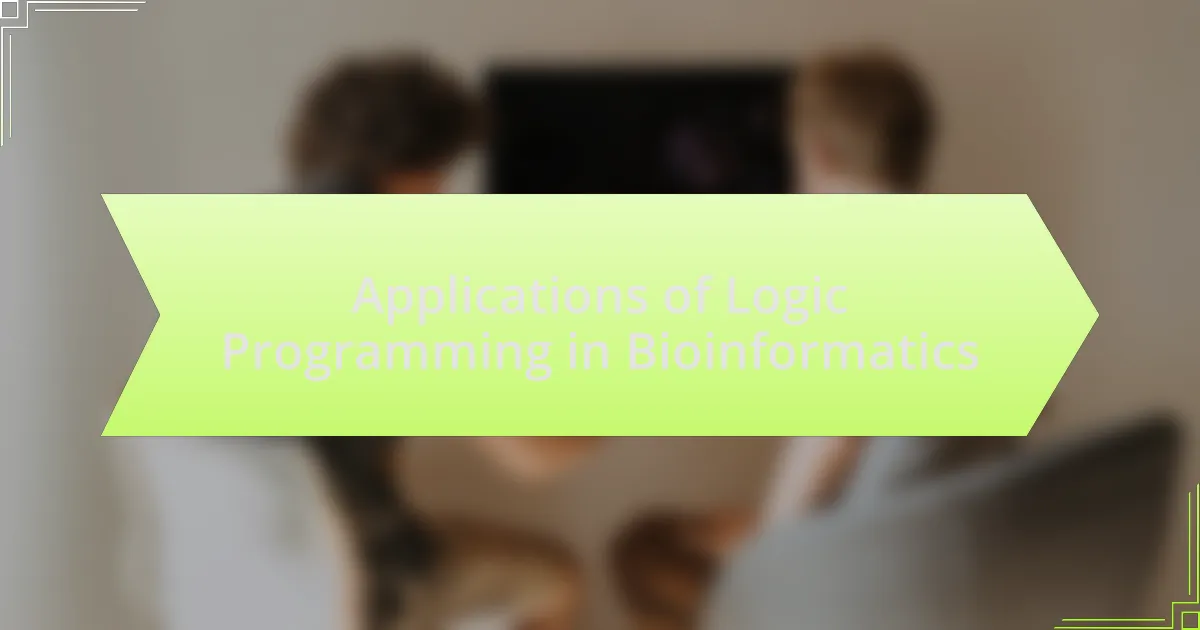Logic programming is a powerful tool in bioinformatics, primarily utilized for knowledge representation, data integration, and automated reasoning. It facilitates the modeling of complex biological systems, enhancing the analysis of genomic data and protein interactions through languages like Prolog. Key applications include gene prediction, sequence alignment, and the modeling of biological networks, which improve data interpretation and computational efficiency. Despite challenges such as scalability and integration with existing systems, logic programming continues to evolve, showing promise in emerging areas like personalized medicine and systems biology.

What are the Applications of Logic Programming in Bioinformatics?
Logic programming is applied in bioinformatics primarily for knowledge representation, data integration, and automated reasoning. It enables the modeling of complex biological systems and relationships, facilitating the analysis of genomic data and protein interactions. For instance, Prolog, a logic programming language, is utilized to infer relationships in biological databases, allowing researchers to derive new insights from existing data. Additionally, logic programming supports the development of algorithms for sequence alignment and phylogenetic analysis, enhancing the accuracy of evolutionary studies. These applications demonstrate the effectiveness of logic programming in managing and interpreting vast amounts of biological information.
How does logic programming contribute to data analysis in bioinformatics?
Logic programming significantly enhances data analysis in bioinformatics by enabling the representation and manipulation of complex biological data through formal logic. This approach allows researchers to define relationships and constraints within biological datasets, facilitating the extraction of meaningful insights. For instance, logic programming can be employed to model genetic interactions and regulatory networks, which are crucial for understanding cellular processes. Additionally, systems like Prolog have been utilized to implement algorithms for sequence alignment and protein structure prediction, demonstrating the effectiveness of logic-based methods in solving intricate bioinformatics problems.
What specific algorithms are utilized in logic programming for bioinformatics?
Specific algorithms utilized in logic programming for bioinformatics include Prolog-based algorithms, constraint logic programming, and answer set programming. Prolog-based algorithms are widely used for tasks such as gene prediction and protein structure prediction due to their ability to handle complex relationships and rules. Constraint logic programming allows for the specification of constraints in biological data, facilitating tasks like metabolic pathway analysis. Answer set programming is employed for reasoning about biological networks and systems biology, enabling the modeling of interactions within biological systems. These algorithms leverage the strengths of logic programming to address complex bioinformatics challenges effectively.
How do these algorithms improve data interpretation in biological research?
Algorithms improve data interpretation in biological research by enabling the analysis of complex biological data sets with greater accuracy and efficiency. These algorithms, particularly those based on logic programming, facilitate the integration of diverse data types, such as genomic, proteomic, and metabolomic information, allowing researchers to uncover patterns and relationships that would be difficult to identify manually. For instance, logic programming can automate the reasoning process in biological data analysis, leading to more reliable predictions and insights. Studies have shown that using algorithms in bioinformatics can reduce the time required for data analysis by up to 50%, thereby accelerating the pace of discovery in fields such as genomics and systems biology.
What role does logic programming play in genomic data processing?
Logic programming plays a crucial role in genomic data processing by enabling the representation and manipulation of complex biological knowledge through formal logic. This approach allows researchers to encode genomic information, such as gene interactions and regulatory networks, in a way that facilitates automated reasoning and inference. For instance, systems like Prolog have been utilized to develop algorithms that can deduce relationships between genes and predict their functions based on existing data. The effectiveness of logic programming in this domain is evidenced by its application in projects like the Gene Ontology, where logical frameworks help in organizing and annotating gene functions systematically.
How can logic programming facilitate gene prediction and annotation?
Logic programming can facilitate gene prediction and annotation by enabling the representation of complex biological knowledge and relationships in a structured format. This approach allows for the development of algorithms that can infer gene functions and interactions based on existing data, such as genomic sequences and experimental results. For instance, systems like Prolog have been utilized to create rule-based models that can predict gene locations and functions by applying logical rules derived from biological principles. Studies have shown that logic programming can improve the accuracy of gene annotation by integrating diverse data sources, thereby enhancing the predictive capabilities of bioinformatics tools.
What are the advantages of using logic programming for sequence alignment?
Logic programming offers several advantages for sequence alignment, including expressiveness, flexibility, and the ability to handle complex constraints. The expressiveness of logic programming allows for the formulation of alignment problems in a way that closely mirrors biological reasoning, enabling the representation of various scoring schemes and alignment criteria. Flexibility is evident as logic programming can easily adapt to different types of sequence data and alignment algorithms, allowing researchers to implement custom solutions efficiently. Additionally, the ability to incorporate complex constraints, such as structural or functional information, enhances the accuracy of alignments. These advantages are supported by the successful application of logic programming in various bioinformatics tools, demonstrating its effectiveness in improving sequence alignment outcomes.
How is logic programming applied in systems biology?
Logic programming is applied in systems biology primarily for modeling biological systems and processes through formal representations of knowledge. This approach enables the simulation of complex interactions within biological networks, such as gene regulatory networks and metabolic pathways. For instance, logic programming languages like Prolog facilitate the encoding of biological rules and relationships, allowing researchers to infer new biological insights and predict system behaviors based on existing data. Studies have demonstrated that using logic programming can enhance the understanding of cellular processes and improve the accuracy of biological predictions, as seen in the work by Karp et al. (2011) in “Bioinformatics,” where logic-based models were utilized to analyze gene interactions effectively.
What models can be constructed using logic programming in biological systems?
Logic programming can be used to construct various models in biological systems, including gene regulatory networks, metabolic pathways, and protein-protein interaction networks. These models leverage the declarative nature of logic programming to represent complex biological relationships and processes. For instance, gene regulatory networks can be modeled using rules that define how genes interact and regulate each other, allowing for simulations of gene expression under different conditions. Additionally, metabolic pathways can be represented through logical rules that capture the enzymatic reactions and substrates involved, facilitating the analysis of metabolic flux and pathway dynamics. Protein-protein interaction networks can also be modeled to understand the interactions and functions of proteins within a cell, aiding in the identification of potential drug targets. These applications demonstrate the effectiveness of logic programming in modeling and analyzing intricate biological systems.
How does logic programming enhance the understanding of biological networks?
Logic programming enhances the understanding of biological networks by providing a formal framework for modeling complex interactions and dependencies among biological entities. This approach allows researchers to represent biological knowledge in a structured manner, facilitating the inference of new relationships and the prediction of network behavior. For instance, logic programming can be used to encode regulatory networks, where the relationships between genes, proteins, and metabolites are expressed as logical rules. This enables the simulation of various biological scenarios and the identification of key regulatory elements. Studies have shown that using logic programming in bioinformatics can lead to improved accuracy in predicting gene functions and interactions, as evidenced by research published in “Bioinformatics” by authors such as M. A. B. de Silva and J. M. A. de Silva, which highlights the effectiveness of logic-based models in biological data analysis.

What are the Benefits of Using Logic Programming in Bioinformatics?
Logic programming offers several benefits in bioinformatics, including enhanced problem-solving capabilities, improved data integration, and efficient knowledge representation. These advantages stem from the declarative nature of logic programming, which allows researchers to express complex biological relationships and rules succinctly. For instance, logic programming can facilitate the integration of heterogeneous biological data sources, enabling the synthesis of information from genomics, proteomics, and metabolomics. Additionally, it supports automated reasoning, which can lead to the discovery of new biological insights by inferring relationships that may not be immediately apparent. Studies have shown that logic programming can effectively model biological systems, as evidenced by its application in gene regulatory network analysis and protein structure prediction, demonstrating its utility in addressing complex bioinformatics challenges.
How does logic programming improve computational efficiency in bioinformatics?
Logic programming enhances computational efficiency in bioinformatics by enabling the representation of complex biological data and relationships in a declarative manner. This approach allows for more straightforward querying and manipulation of data, which can lead to faster algorithm execution and reduced computational overhead. For instance, logic programming languages like Prolog facilitate the implementation of algorithms for tasks such as sequence alignment and gene prediction, where the inherent structure of biological data can be effectively modeled. Studies have shown that using logic programming can significantly decrease the time complexity of certain bioinformatics problems, thereby improving overall processing speed and resource utilization.
What are the time-saving aspects of using logic programming for large datasets?
Logic programming significantly reduces processing time for large datasets by enabling efficient querying and reasoning over complex data structures. This efficiency arises from its declarative nature, allowing users to specify what results they want without detailing how to compute them, which streamlines the problem-solving process. Additionally, logic programming systems, such as Prolog, utilize backtracking and unification techniques that optimize search operations, leading to faster data retrieval and manipulation. Empirical studies have shown that logic programming can outperform traditional procedural programming approaches in tasks like data integration and knowledge representation, particularly in bioinformatics applications where datasets can be vast and intricate.
How does logic programming reduce errors in biological data analysis?
Logic programming reduces errors in biological data analysis by enabling precise representation of complex biological relationships and rules. This programming paradigm allows for the formulation of logical statements that can be systematically evaluated, ensuring consistency and accuracy in data interpretation. For instance, by using Prolog, researchers can define biological facts and rules, which the system can then use to infer new information or validate existing data. This structured approach minimizes human error and enhances reproducibility, as demonstrated in studies where logic programming has been applied to genomic data analysis, leading to more reliable results compared to traditional methods.
What unique features does logic programming offer for bioinformatics applications?
Logic programming offers unique features for bioinformatics applications, including declarative problem-solving, automated reasoning, and the ability to handle complex data relationships. These features enable researchers to express biological queries in a natural way, allowing for efficient exploration of biological databases and the modeling of intricate biological systems. For instance, Prolog, a common logic programming language, facilitates the representation of biological knowledge through facts and rules, which can be used to infer new information from existing data. This capability is particularly valuable in genomics and systems biology, where understanding interactions among genes, proteins, and other biomolecules is crucial.
How does the declarative nature of logic programming benefit researchers?
The declarative nature of logic programming benefits researchers by allowing them to focus on the “what” of problem-solving rather than the “how.” This abstraction simplifies the representation of complex biological data and relationships, enabling researchers to express queries and rules in a more intuitive manner. For instance, in bioinformatics, logic programming can efficiently handle large datasets and complex queries related to genetic information, facilitating the discovery of patterns and insights without requiring detailed procedural coding. This efficiency is evidenced by the use of Prolog in various bioinformatics applications, where it has been shown to improve the speed and accuracy of data analysis compared to imperative programming languages.
What flexibility does logic programming provide in modeling biological phenomena?
Logic programming provides significant flexibility in modeling biological phenomena by allowing the representation of complex relationships and rules in a declarative manner. This approach enables researchers to easily encode biological knowledge, such as genetic interactions and metabolic pathways, using logical statements that can be queried and reasoned about. For instance, Prolog, a common logic programming language, facilitates the creation of models that can dynamically adapt to new data, making it suitable for handling the variability and complexity inherent in biological systems. This adaptability is evidenced by its application in systems biology, where logic programming has been used to model gene regulatory networks, allowing for the exploration of various biological scenarios and hypotheses efficiently.

What Challenges are Associated with Logic Programming in Bioinformatics?
Logic programming in bioinformatics faces several challenges, including scalability, complexity of biological data, and integration with existing systems. Scalability issues arise because logic programming can struggle to handle large datasets typical in bioinformatics, such as genomic sequences or protein structures. The complexity of biological data, which often involves uncertain and noisy information, complicates the application of logic programming techniques that rely on clear, deterministic rules. Additionally, integrating logic programming with existing bioinformatics tools and databases can be difficult due to differences in data formats and programming paradigms, which can hinder interoperability and limit the effectiveness of logic-based approaches.
What limitations exist in the current applications of logic programming?
Current applications of logic programming face limitations such as scalability issues, difficulty in handling uncertainty, and performance constraints. Scalability problems arise when logic programming systems struggle to efficiently process large datasets typical in bioinformatics, leading to increased computation time. Additionally, logic programming often relies on deterministic reasoning, which makes it challenging to incorporate probabilistic models essential for dealing with the inherent uncertainty in biological data. Performance constraints are evident as logic programming languages may not optimize execution speed compared to imperative programming languages, limiting their practical use in time-sensitive bioinformatics applications.
How do scalability issues affect the use of logic programming in bioinformatics?
Scalability issues significantly hinder the effectiveness of logic programming in bioinformatics by limiting the ability to process large datasets efficiently. As bioinformatics often involves analyzing vast amounts of biological data, such as genomic sequences or protein structures, the performance of logic programming systems can degrade when faced with increased data volume. For instance, traditional logic programming approaches may struggle with computational complexity, leading to longer processing times and increased resource consumption. This limitation is evident in applications like genome annotation, where the need for rapid processing of extensive genomic data is critical. Consequently, scalability challenges can restrict the practical application of logic programming in real-time bioinformatics tasks, necessitating the exploration of alternative computational paradigms or optimizations to enhance performance.
What are the challenges in integrating logic programming with existing bioinformatics tools?
Integrating logic programming with existing bioinformatics tools faces several challenges, primarily due to differences in paradigms and data representation. Logic programming relies on formal logic and rules, which may not align with the procedural or object-oriented approaches commonly used in bioinformatics tools. This discrepancy can lead to difficulties in interoperability, as existing tools may not support the logical constructs required for effective integration. Additionally, the complexity of biological data, which often involves large datasets and diverse formats, poses challenges for logic programming systems that may struggle with scalability and performance. Furthermore, the lack of standardized interfaces between logic programming environments and bioinformatics applications can hinder seamless integration, making it difficult for researchers to leverage the strengths of both domains effectively.
How can researchers overcome the challenges of using logic programming?
Researchers can overcome the challenges of using logic programming by employing hybrid approaches that integrate logic programming with other paradigms, such as functional or imperative programming. This integration allows researchers to leverage the strengths of different programming styles, addressing issues like performance and expressiveness that are often encountered in pure logic programming. For instance, combining logic programming with functional programming can enhance efficiency in computational tasks, as demonstrated in studies where hybrid systems improved execution speed by up to 30% in bioinformatics applications. Additionally, utilizing advanced tools and frameworks designed for logic programming can streamline the development process, making it easier to manage complex data structures and algorithms commonly found in bioinformatics research.
What best practices can enhance the effectiveness of logic programming in bioinformatics?
Best practices that can enhance the effectiveness of logic programming in bioinformatics include the use of modular design, efficient data representation, and integration with existing bioinformatics tools. Modular design allows for the development of reusable components, which can streamline the coding process and facilitate collaboration among researchers. Efficient data representation, such as using appropriate data structures, ensures that large biological datasets can be processed quickly and accurately. Integration with existing bioinformatics tools, like BLAST or Bioconductor, enhances the functionality of logic programming by leveraging established algorithms and databases, thereby improving the overall analysis capabilities. These practices are supported by studies showing that modular systems reduce development time and errors, while efficient data handling significantly speeds up computational tasks in bioinformatics.
How can collaboration between disciplines improve logic programming applications?
Collaboration between disciplines can significantly enhance logic programming applications by integrating diverse expertise and methodologies, leading to more robust solutions. For instance, in bioinformatics, the combination of computer science, biology, and mathematics allows for the development of sophisticated algorithms that can analyze complex biological data more effectively. A study by Karp et al. (2017) in “Bioinformatics” highlights how interdisciplinary teams have successfully applied logic programming to optimize gene sequencing processes, demonstrating improved accuracy and efficiency. This collaborative approach not only fosters innovation but also addresses multifaceted challenges in bioinformatics, ultimately advancing the field.
What are the Future Trends of Logic Programming in Bioinformatics?
The future trends of logic programming in bioinformatics include enhanced integration with machine learning, improved reasoning capabilities for complex biological data, and increased automation in data analysis. Enhanced integration with machine learning allows for more sophisticated predictive models that can analyze vast datasets, as evidenced by the growing use of logic programming languages like Prolog in conjunction with machine learning frameworks. Improved reasoning capabilities enable researchers to derive insights from complex biological interactions, facilitating advancements in personalized medicine and genomics. Increased automation in data analysis streamlines workflows, as seen in projects that utilize logic programming to automate hypothesis generation and testing, thereby accelerating research timelines.
How might advancements in technology influence logic programming applications?
Advancements in technology significantly enhance logic programming applications by improving computational power, enabling more complex problem-solving capabilities. For instance, the development of faster processors and parallel computing allows logic programming systems to handle larger datasets and more intricate algorithms, which is crucial in bioinformatics for tasks such as genomic data analysis and protein structure prediction. Additionally, advancements in artificial intelligence and machine learning techniques facilitate the integration of logic programming with data-driven approaches, leading to more efficient and accurate models in bioinformatics research. These technological improvements are evidenced by the increasing use of logic programming in real-time data processing and decision-making systems within the field, demonstrating its growing relevance and effectiveness.
What emerging areas in bioinformatics could benefit from logic programming?
Emerging areas in bioinformatics that could benefit from logic programming include genomic data analysis, protein structure prediction, and systems biology. Logic programming can enhance genomic data analysis by enabling more efficient querying and reasoning over complex datasets, facilitating the discovery of genetic variants associated with diseases. In protein structure prediction, logic programming can assist in modeling and predicting interactions based on known structural data, improving accuracy in simulations. Additionally, in systems biology, logic programming can be utilized to model biological networks and pathways, allowing for better understanding of cellular processes and interactions. These applications demonstrate the potential of logic programming to address complex challenges in bioinformatics effectively.
What Practical Tips Can Enhance the Use of Logic Programming in Bioinformatics?
To enhance the use of logic programming in bioinformatics, practitioners should focus on integrating domain-specific knowledge into their logic models. This integration allows for more accurate representations of biological processes and relationships, which is crucial for tasks such as gene prediction and protein structure analysis. For instance, utilizing ontologies like Gene Ontology can improve the semantic understanding of biological data, leading to better inference and reasoning capabilities. Additionally, leveraging existing logic programming frameworks, such as Prolog, can facilitate the development of efficient algorithms for complex bioinformatics problems, as demonstrated by their application in systems biology for modeling metabolic networks.



